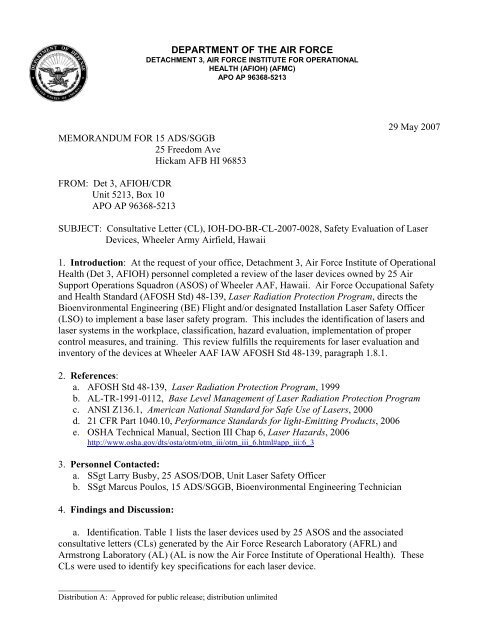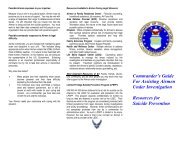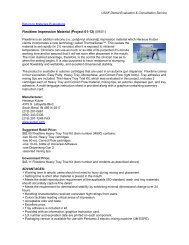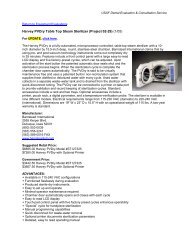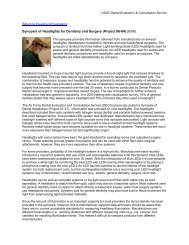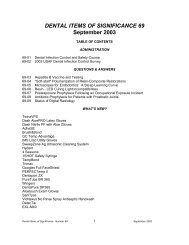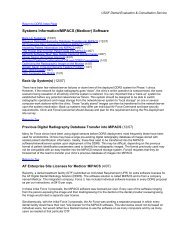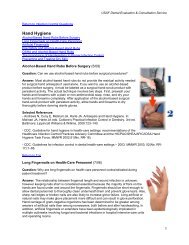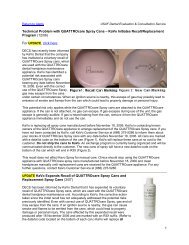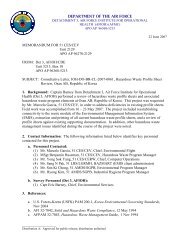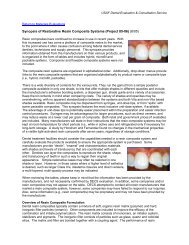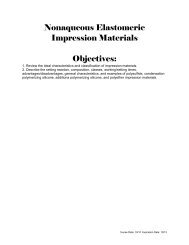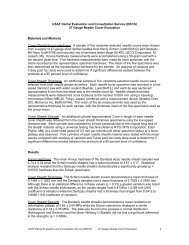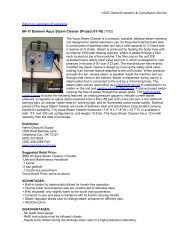IOH-DO-BR-CL-2007-0028 - Air Force Surgeon General
IOH-DO-BR-CL-2007-0028 - Air Force Surgeon General
IOH-DO-BR-CL-2007-0028 - Air Force Surgeon General
You also want an ePaper? Increase the reach of your titles
YUMPU automatically turns print PDFs into web optimized ePapers that Google loves.
MEMORANDUM FOR 15 ADS/SGGB<br />
25 Freedom Ave<br />
Hickam AFB HI 96853<br />
FROM: Det 3, AF<strong>IOH</strong>/CDR<br />
Unit 5213, Box 10<br />
APO AP 96368-5213<br />
______________<br />
Distribution A: Approved for public release; distribution unlimited<br />
29 May <strong>2007</strong><br />
SUBJECT: Consultative Letter (<strong>CL</strong>), <strong>IOH</strong>-<strong>DO</strong>-<strong>BR</strong>-<strong>CL</strong>-<strong>2007</strong>-<strong>0028</strong>, Safety Evaluation of Laser<br />
Devices, Wheeler Army <strong>Air</strong>field, Hawaii<br />
1. Introduction: At the request of your office, Detachment 3, <strong>Air</strong> <strong>Force</strong> Institute of Operational<br />
Health (Det 3, AF<strong>IOH</strong>) personnel completed a review of the laser devices owned by 25 <strong>Air</strong><br />
Support Operations Squadron (ASOS) of Wheeler AAF, Hawaii. <strong>Air</strong> <strong>Force</strong> Occupational Safety<br />
and Health Standard (AFOSH Std) 48-139, Laser Radiation Protection Program, directs the<br />
Bioenvironmental Engineering (BE) Flight and/or designated Installation Laser Safety Officer<br />
(LSO) to implement a base laser safety program. This includes the identification of lasers and<br />
laser systems in the workplace, classification, hazard evaluation, implementation of proper<br />
control measures, and training. This review fulfills the requirements for laser evaluation and<br />
inventory of the devices at Wheeler AAF IAW AFOSH Std 48-139, paragraph 1.8.1.<br />
2. References:<br />
a. AFOSH Std 48-139, Laser Radiation Protection Program, 1999<br />
b. AL-TR-1991-0112, Base Level Management of Laser Radiation Protection Program<br />
c. ANSI Z136.1, American National Standard for Safe Use of Lasers, 2000<br />
d. 21 CFR Part 1040.10, Performance Standards for light-Emitting Products, 2006<br />
e. OSHA Technical Manual, Section III Chap 6, Laser Hazards, 2006<br />
http://www.osha.gov/dts/osta/otm/otm_iii/otm_iii_6.html#app_iii:6_3<br />
3. Personnel Contacted:<br />
a. SSgt Larry Busby, 25 ASOS/<strong>DO</strong>B, Unit Laser Safety Officer<br />
b. SSgt Marcus Poulos, 15 ADS/SGGB, Bioenvironmental Engineering Technician<br />
4. Findings and Discussion:<br />
DEPARTMENT OF THE AIR FORCE<br />
DETACHMENT 3, AIR FORCE INSTITUTE FOR OPERATIONAL<br />
HEALTH (AF<strong>IOH</strong>) (AFMC)<br />
APO AP 96368-5213<br />
a. Identification. Table 1 lists the laser devices used by 25 ASOS and the associated<br />
consultative letters (<strong>CL</strong>s) generated by the <strong>Air</strong> <strong>Force</strong> Research Laboratory (AFRL) and<br />
Armstrong Laboratory (AL) (AL is now the <strong>Air</strong> <strong>Force</strong> Institute of Operational Health). These<br />
<strong>CL</strong>s were used to identify key specifications for each laser device.
Table 1: Laser Systems<br />
Nomenclature Acronym Quantity Consultative Letter #<br />
Mark VII Rangefinder Mark VII 15 AFRL-HE-<strong>BR</strong>-<strong>CL</strong>-2003-0009<br />
Ground Commanders Pointer GCP 1A 30 AL-OE-<strong>CL</strong>-1995-0279<br />
Infrared Zoom Laser Illuminator/Designator IZLIDS II 15 AFRL-HE-<strong>BR</strong>-TM-2000-0008<br />
Special Operations <strong>Force</strong>s Laser Marker SOFLAM 15 AFRL-HE-<strong>BR</strong>-TR-2003-0136<br />
b. Background Information.<br />
(1) The Mark VII is a handheld target location system with a Class 1 laser range finder<br />
with switchable direct view and image intensifier capability. The system also has an imbedded<br />
magnetic compass that provides ranges, azimuth and elevation data output for accurate target<br />
location determination.<br />
(2) The GCP 1A is an illuminator system used by special operations personnel to<br />
illuminate ground targets for A-10 aircraft target acquisition.<br />
(3) The IZLIDS II is a handheld laser target illuminator/designator. The laser produces an<br />
infrared (870 nm) beam ideal for night operations. This laser was developed for special operation<br />
forces to illuminate or designate targets for pilots during night conditions.<br />
(4) The SOFLAM is a man-transportable laser target marker and rangefinder. It is used<br />
mostly by special operations personnel to determine range to targets or for marking targets for<br />
laser guided smart weapons.<br />
c. Terminology. Chapters 3 and 4 of AFOSH Std 48-139 list the terminology for laser<br />
evaluations and appropriate control measures. The key terms from these chapters are:<br />
(1) Maximum Permissible exposure (MPE) – is the maximum level of laser radiation to<br />
which a human can be exposed without adverse biological effects to the eye or skin, units J/cm 2<br />
or W/cm 2 .<br />
(2) Nominal Ocular Hazard Distance (NOHD) – is the distance along the axis of the<br />
direct laser beam to the human eye beyond which the MPE of the laser is not exceeded. See<br />
Figure 1 for an example of this concept.<br />
(3) Laser Classification – lasers are classified under the Federal Drug Administration<br />
Standard (21 CFR 1040.10). In general terms, lasers are classified as follows:<br />
(a) Class 1 – “safe” if not disassembled, usually a higher class embedded laser<br />
(b) Class 2 – visible laser, eye hazard if you stare into the beam<br />
(c) Class 3a – eye hazard if beam collected or focused into the eye<br />
(d) Class 3b – eye hazard if direct or reflected beam is viewed<br />
(e) Class 4 – eye hazard if direct, reflected or diffusely-reflected beam is viewed;<br />
possible skin and fire hazard<br />
2
Figure 1: NOHD Illustration<br />
(4) Optical Density (OD) – is a measure of the light transmitted, the greater the OD, the<br />
greater the attenuation effect. OD = log {1/(% transmission)}. See Table 2 for an example of this<br />
applied calculation.<br />
Table 2: Optical Density Examples<br />
Optical<br />
Density (OD)<br />
% Transmitted Reduction Factor<br />
0 100 1<br />
1 10 10<br />
2 1 100<br />
3 0.1 1000<br />
4 0.001 10000<br />
5 0.0001 100000<br />
d. Specifications. Table 3 lists the laser classification, MPE, NOHD and OD requirements<br />
for each laser systems operated by 25 ASOS. The information in the table was generated from<br />
information obtained from the <strong>CL</strong>s listed in Table 1. This information should provide the<br />
guidelines to complete AF Form 2760, Laser Hazard Evaluation, or equivalent.<br />
3
Table 3: Laser Classification, MPE, NOHD, & OD Requirements<br />
Mark VII IZLID II IZLID II SOFLAM GCP - 1A<br />
Class 1 4 4 4 3b<br />
Wavelength<br />
(nanometers)<br />
1570 867 867 1064 830<br />
Output Power 5.06 x 10 -3 J 543 mW 543 mW 110 mJ 50 mW<br />
Operational Mode Single Pulse Pulsed Pulsed Pulsed CW<br />
MPE (Intra-Beam)<br />
Exposure Duration<br />
(seconds)<br />
1 J/cm 2<br />
(per pulse)<br />
2.18 x 10 -3 W/cm 2<br />
2.18 x 10 -3 W/cm 2 1.33 x 10 -6 J/cm 2 1.84 x 10 -2 J/cm 2<br />
Laser Safety Training<br />
1. Laser Basics - Definition/Use: LASER stands for Light Amplification by Stimulated Emission of Radiation. Lasers<br />
are used in research, medicine, industry, and commercial and military applications. Some common uses include eye<br />
surgery, supermarket checkout scanners, engineering surveying, engraving, cutting and welding, and targeting for<br />
military weapon systems. A laser can deposit a lot of energy within a small area.<br />
2. Laser Bioeffects: Damage to the eyes and skin is of most concern in laser accidents. Thermal effects are the major<br />
cause of tissue damage by lasers. Energy from the laser is absorbed by the tissue in the form of heat, which can cause<br />
localized, intense heating of sensitive tissues. The amount of thermal damage that can be caused to tissue varies<br />
depending on the thermal sensitivity of the type of tissue. Thermal effects can range from erythema (reddening of the<br />
skin) to burning of the tissue. Factors that affect thermal damage to tissue are: amount of tissue affected, wavelength of<br />
light, energy of the beam, and length of time that the tissue is irradiated. Laser beams are capable of causing a<br />
localized vaporization of tissue which in turn can create a mechanical shockwave to be propagated through the tissue<br />
(acoustic effects). Shockwaves can cause tearing of tissue. Laser light can also cause changes to the chemistry of cells,<br />
which can result in changes to tissue (photochemical effects).<br />
3. Eye Anatomy: The three parts of the eye of concern in laser injuries are the cornea, lens and retina. The cornea is<br />
the transparent layer of tissue covering the surface of the eye. The cells on the surface of the cornea have a lifetime of<br />
only about 48 hours, therefore cell turnover is quite fast. Injury to cells on the surface of the cornea is generally<br />
repaired quickly, but injury to deeper layers of the cornea can result in permanent change to the cornea. The lens of the<br />
eye focuses light to form images in the eye. Damage to the lens can cause the destructive interference of light within<br />
the lens, resulting in a "milky" area or cataract. The retina is made up of layers of nerve cells and is used for reception<br />
of the light in the eye. Damage to cells in the retina can result in loss of vision.<br />
4. Eye Damage and Laser Wavelength: Visible and IR-A wavelengths of light are transmitted through the cornea and<br />
lens of the eye, and are absorbed mostly by the retina. The visible and IR-A portions of the spectrum (400-1200 nm)<br />
are often referred to as the "Retinal Hazard Region" because these wavelengths of light can damage the retina. The<br />
amount of hazard to the retina from viewing of a laser beam in the Retinal Hazard Region increases with increased<br />
pupil size and increased duration of the laser beam. UV-A wavelengths of light are mostly absorbed in the lens of the<br />
eye and can cause photochemical damage to the lens. UV-B, UV-C, IR-B and IR-C are absorbed by the cornea of the<br />
eye. Exposure to these wavelengths can result in conjunctivitis, "milky" cornea, and inflammation.<br />
5. Potential Skin Damage from Lasers: The layers of the skin that are of concern in a discussion of laser hazards to the<br />
skin are the epidermis and the dermis. The epidermis layer lies beneath the stratum corneum and is the outermost living<br />
layer of the skin. UV-B and UV-C, often collectively referred to as "actinic UV," can cause erythema and blistering as<br />
they are absorbed in the epidermis. UV-B is a component of sunlight that is thought to have carcinogenic effects on the<br />
skin. The dermis mostly consists of connective tissue and lies beneath the epidermis. IR-A wavelengths of light are<br />
absorbed by the dermis and can cause deep heating of skin tissue.<br />
6. Laser Exposure Limits: The MPE, or Maximum Permissible Exposure, is the maximum level of laser radiation to<br />
which a human can be exposed without adverse biological effects to the eye or skin. There are three factors involved in<br />
the determination of the MPE which are the wavelength of the laser light, the energy involved in the exposure, and the<br />
duration of the exposure. AFOSH Standard 48-139 has accepted the MPE values found in ANSI Standard Z136.1 as<br />
the US <strong>Air</strong> <strong>Force</strong> standard. NHZ stands for Nominal Hazard Zone, and is the zone inside which laser radiation that is<br />
direct, reflected, or scattered exceeds the MPE for the laser. Control measures are not needed outside the NHZ. The<br />
NOHD is an acronym for Nominal Ocular Hazard Distance. The NOHD is the distance along the axis of the direct<br />
laser beam to the human eye beyond which the MPE of the laser is not exceeded.<br />
7. Non-beam Hazards - Electrical: The most widely encountered non-beam hazard from lasers is electric shock, or<br />
even death, from sources of electricity. Sources of electrical hazard from lasers come primarily from the power supply<br />
of continuous wave lasers and the capacitor banks of pulsed lasers. The following precautions should be followed to<br />
help prevent electrical injury when working around laser equipment:<br />
• Avoid wearing metallic items.<br />
• Never handle electrical equipment when hands are wet or when standing on wet ground.<br />
• It is recommended that personnel should be trained in CPR in case an electrical accident occurs.<br />
8. Non-beam Hazards - Chemical: One of the major sources of chemical hazards from lasers is from the organic dyes<br />
used in dye lasers. Most dyes used in dye lasers are fluorescent organic compounds. Some dyes (the rhodamines) are<br />
<strong>IOH</strong>-<strong>DO</strong>-<strong>BR</strong>-<strong>CL</strong>-<strong>2007</strong>-<strong>0028</strong>, Atch 1<br />
1 of 3
considered to be mutagenic or carcinogenic, while other dyes (polymethine compounds) are toxic. Additionally, some<br />
of the solvents used during dye preparation can be irritants, highly toxic, and/or highly reactive. Other hazards include<br />
gases from gas lasers, as well as gases that are formed by the interaction of the laser with target materials, and coolants<br />
such as liquid nitrogen. To prevent chemical accidents, the following are suggested:<br />
• Personal protective equipment such as lab coats, gloves and goggles, should be worn.<br />
• Dye solutions and reagents should be stored properly.<br />
• Adequate ventilation shall be provided if gases are produced.<br />
• Use standard laboratory safety techniques to prevent injury (PPE, proper chemical storage, fume hood).<br />
9. Non-beam Hazards - Optical: There are hazards from light generated by lasers that do not originate from the beam<br />
itself. These optical hazards include UV light as a product of laser welding, UV light from discharge tubes and<br />
pumping lamps, visible and IR-A light from pumping systems. To prevent non-beam optical injuries, hazardous levels<br />
of non-beam optical emissions should be shielded.<br />
10. Non-beam Hazards - Explosion: The following are potential sources for explosion hazards in lasers: lamps (arc<br />
lamps, filament lamps), capacitor banks, and static electricity buildup in circulating dye solutions containing non-polar<br />
solvents such as dioxane. To prevent explosion hazards:<br />
• Components that are capable of exploding shall be enclosed in housings that can withstand a potential<br />
explosion.<br />
• Use static dissipaters (ground wire) in tubing for circulating dye solution.<br />
11. Non-beam Hazards - Fire: Potential sources of fire hazards include electrical circuits, improper beam enclosures,<br />
ignition of gases or fumes from the laser, and flammable laser dyes. In order to prevent fire hazard:<br />
• Beam enclosures should be constructed of flame resistant materials.<br />
• Electrical circuitry shall be evaluated for the potential to cause fire.<br />
12. Laser Hazard Classifications:<br />
• Class 1 - “safe” if not disassembled.<br />
• Class 2/2a - eye hazard if you stare into beam.<br />
• Class 3a - eye hazard if collected or focused into eye.<br />
• Class 3b - eye hazard if direct or reflected beam is viewed.<br />
• Class 4 - eye hazard if direct, reflected or diffusely-reflected beam is viewed; possible skin and fire hazard.<br />
13. Engineering Control Measures: Engineering controls are design features or devices that are applied to a laser or its<br />
environment for the purpose of reducing laser hazards. Engineering controls are considered to be the most effective<br />
types of control. Examples of engineering controls are beam housings, beam shutters, attenuators, and remote firing<br />
controls. A list of engineering control measures for each laser class is available on the AF Form 2760, Laser Hazard<br />
Evaluation, or on the OSHA website (http://www.osha.gov/dts/osta/otm/otm_iii/otm_iii_6.html#6)<br />
14. Administrative Control Measures: Administrative controls consist of procedures and information provided to<br />
personnel for the purpose of reducing laser hazards. Examples of administrative controls include warning signs and<br />
labels, standard operating procedures, and safety training. A list of required and recommended administrative control<br />
measures for each laser class is available on the AF Form 2760.<br />
15. Personal Protective Equipment (PPE): Of particular importance in prevention of laser hazards is eyewear. Laser<br />
protective eyewear is usually made of filters that absorb and/or reflect specific wavelengths of laser light. An important<br />
factor to look for in choosing laser protective eyewear is the optical density (OD) of the lenses. The OD of the eyewear<br />
is a measure of its capacity to filter light; OD is the opposite of transmission. The higher the OD, the less the light that<br />
is transmitted to the eye. The OD must be chosen so as not to impair vision significantly, yet at the same time, must be<br />
chosen so as to be capable of reducing the laser light to the MPE. When choosing laser protective eyewear it is also<br />
important to select eyewear that is designed to protect against the wavelengths of the laser light that will be used.<br />
Eyewear designed to filter shorter wavelengths of light are not appropriate for use with lasers that emit longer<br />
wavelengths of light. Finally, it is also important that some attention be paid to the style of the laser protective<br />
<strong>IOH</strong>-<strong>DO</strong>-<strong>BR</strong>-<strong>CL</strong>-<strong>2007</strong>-<strong>0028</strong>, Atch 1<br />
2 of 3
eyewear so that comfort to the wearer is maximized. Laser protective eyewear cannot protect personnel if not<br />
worn.<br />
18. Common Causes of Accidents: Some common causes of laser accidents include altering beam path (e.g., adding<br />
optical components without regard to beam path), inserting reflective objects into beam path, bypassing interlocks<br />
(particularly during alignment), accidentally turning on power supply, accidental firing of laser, and not wearing<br />
protective eyewear.<br />
19. <strong>General</strong> Safe Work Practices for Lasers:<br />
• Wear appropriate protective eyewear<br />
• Use minimum power/energy required for project<br />
• Reduce laser output with shutters/attenuators, if possible<br />
• Terminate laser beam with beam trap<br />
• Use protective screens, remote viewing systems, etc., during alignments, if possible<br />
• Remove unnecessary objects from vicinity of laser<br />
• Keep beam path away from eye level (sitting or standing)<br />
• Don’t put your body parts (particularly your eyes) in the beam!<br />
20. Training Requirements: AFOSH Standard 48-139, paragraph 1.12.., requires that the Unit Safety Officer conduct<br />
initial and annual laser safety training. The Unit Safety Officer will ensure that laser users are knowledgeable of the<br />
potential laser and ancillary hazards and the control measures to use. Ensure training is documented on the AF Form<br />
55.<br />
21. Procedures to follow in the event of a suspected exposure to laser radiation:<br />
• See immediate medical care.<br />
• Call the USAF Laser Hotline at 1-800-473-3549.<br />
• Immediately notify the supervisor, Unit Safety Officer, Commander, and Bioenvironmental Engineering at<br />
DSN 314-226-8548 or if after duty DSN 314-226-4226.<br />
• Immediately take the laser out of service until an investigation can be completed.<br />
• Follow guidance in AFOSH Standard 48-139, paragraph 2.6.<br />
22. Additional Laser Information: Additional information including laser safety training materials can be<br />
found on the OSHA website (www.osha.gov) and the University of Illinois website<br />
(http://www.ehs.uiuc.edu/rss/laser/index.htm).<br />
I, __________________________________, have read and understand the information above. Laser<br />
Safety Training has been documented on my AF Form 55.<br />
Signed:____________________________________ Date:_________________________________<br />
<strong>IOH</strong>-<strong>DO</strong>-<strong>BR</strong>-<strong>CL</strong>-<strong>2007</strong>-<strong>0028</strong>, Atch 1<br />
3 of 3


